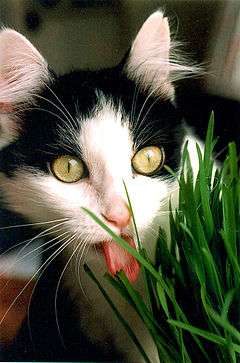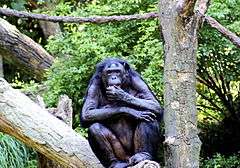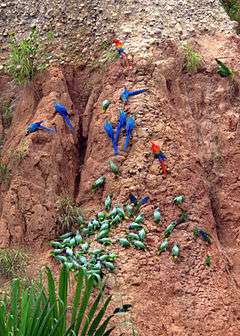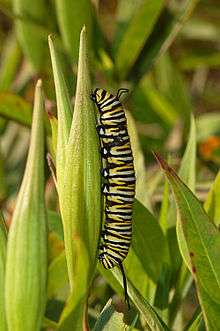Zoopharmacognosy

Zoopharmacognosy is a behaviour in which non-human animals apparently self-medicate by selecting and ingesting or topically applying plants, soils, insects, and psychoactive drugs to prevent or reduce the harmful effects of pathogens and toxins.[1][2] The term derives from Greek roots zoo ("animal"), pharma ("drug"), and gnosy ("knowing").
A well-known example of zoopharmacognosy occurs when dogs eat grass to induce vomiting. However, the behaviour is more diverse than this. Animals ingest or apply non-foods such as clay, charcoal and even toxic plants and invertebrates, apparently to prevent parasitic infestation or poisoning.[3]
Whether animals truly self-medicate remains a somewhat controversial subject because early evidence is mostly circumstantial or anecdotal,[4] however, more recent examinations have adopted an experimental, hypothesis-driven approach.
The methods by which animals self-medicate vary, but can be classified according to function as prophylactic (preventative, before infection or poisoning) or therapeutic (after infection, to combat the pathogen or poisoning).[4] The behaviour is believed to have widespread adaptive significance.[5]
History and etymology
In 1978, Janzen suggested that vertebrate herbivores might benefit medicinally from the secondary metabolites in their plant food.[6]
In 1993, the term "zoopharmacognosy" was coined, derived from the Greek roots zoo ("animal"), pharma ("drug"), and gnosy ("knowing").[7] The term gained popularity from academic works[4] and in a book by Cindy Engel entitled Wild Health: How Animals Keep Themselves Well and What We Can Learn from Them.[8]
Mechanisms
The anti-parasitic effect of zoopharmacognosy could occur by at least two mechanisms. First, the ingested material may have pharmacological antiparasitic properties such that phytochemicals decrease the ability of worms to attach to the mucosal lining of the intestines, or chemotaxis attracts worms into the folds of leaves. Many ingested plants during purported zoopharmacognosy have a consistent physical property, e.g., the rough surface of the leaves sports many hooked and spiky hairs. So, parasites may became attached to the bristly surface or the coarse structure may function as a rasping plug, dislodging parasites from the intestines. The second possible mode of action is the material may initiate a purging response of the gastrointestinal tract by rapidly inducing diarrhea. This substantially decreases gut transit time, causes worm expulsion and interrupts the life cycle of parasites. This, or a similar, mechanism could explain undigested grass in the faeces of various animals such as birds, carnivores and primates.[9]
Methods of self-medication
Some animals ingest or apply the substance when they appear to be well, suggesting the behaviour is preventative or prophylactic. In other cases, animals ingest or apply the substance when unwell, suggesting the behaviour is therapeutic or curative. There are three methods of self-medication, namely, ingestion, absorption, or topical application.
Ingestion
Many examples of zoopharmacognosy involve an animal ingesting a substance with (potential) medicinal properties.
Ants
Ants infected with Beauveria bassiana, a fungus, selectively consume harmful substances (reactive oxygen species, ROS) upon exposure to a fungal pathogen, yet avoid these in the absence of infection.[10]
Mammals


Great apes often consume plants that have no nutritional values but which have beneficial effects on gut acidity or combat intestinal parasitic infection.[1]
Chimpanzees sometimes select bitter leaves for chewing. Parasite infection drops noticeably after chimpanzees chew leaves of pith (Vernonia amyddalina), which have anti-parasitic activity against schistosoma, plasmodium and Leishmania. Chimpanzees don't consume this plant on a regular basis, but when they do eat it, it is often in small amounts by individuals that appear ill.[12] Jane Goodall witnessed chimpanzees eating particular bushes, apparently to make themselves vomit. There are reports that chimpanzees swallow whole leaves of particular rough-leaved plants such as Aneilema aequinoctiale; these remove parasitic worms from their intestines.[13]
Chimpanzees sometimes eat the leaves of the herbaceous Desmodium gangeticum. Undigested, non-chewed leaves were recovered in 4% of faecal samples of wild chimpanzees and clumps of sharp-edged grass leaves in 2%. The leaves have a rough surface or sharp-edges and the fact they were not chewed and excreted whole indicates they were not ingested for nutritional purposes. Furthermore, this leaf-swallowing was restricted to the rainy season when parasite re-infections are more common, and parasitic worms (Oesophagostomum stephanostomum) were found together with the leaves.[9]
Chimpanzees, bonobos, and gorillas eat the fruits of Aframomum angustifolium. Laboratory assays of homogenized fruit and seed extracts show significant anti-microbial activity.[14] Illustrating the medicinal knowledge of some species, apes have been observed selecting a particular part of a medicinal plant by taking off leaves and breaking the stem to suck out the juice.[15]
Anubis baboons (Papio anubis) and hamadryas baboons (Papio hamadryas) in Ethiopia use fruits and leaves of Balanites aegyptiaca to control schistosomiasis.[16] Its fruits contain diosgenin, a hormone precursor that presumably hinders the development of schistosomes.[4]
African elephants (Loxodonta africana) apparently self-medicate to induce birth by chewing on the leaves of a particular tree from the family Boraginaceae; Kenyan women brew a tea from this tree to induce childbirth.[17]
White-nosed coatis (Nasua narica) in Panama take the menthol-scented resin from freshly scraped bark of Trattinnickia aspera (Burseraceae) and vigorously rub it into their own fur or that of other coatis, possibly to kill ectoparasites such as fleas, ticks, and lice, as well as biting insects such as mosquitoes;[18] the resin contains triterpenes α - and β-amyrin, the eudesmane derivative β-selinene, and the sesquiterpene lactone 8β-hydroxyasterolide.[14]
Domestic cats and dogs often select and ingest plant material, apparently to induce vomiting.[19]
Indian wild boars selectively dig up and eat the roots of pigweed which humans use as an anthelmintic. Mexican folklore indicates that pigs eat pomegranate roots because they contain an alkaloid that is toxic to tapeworms.[20]
A study on domestic sheep (Ovis aries) has provided clear experimental proof of self-medication via individual learning.[6] Lambs in a treatment group were allowed to consume foods and toxins (grain, tannins, oxalic acid) that lead to malaise (negative internal states) and then allowed to eat a substance known to alleviate each malaise (sodium bentonite, polyethylene glycol and dicalcium phosphate, respectively). Control lambs ate the same foods and medicines, but this was disassociated temporally so they did not recuperate from the illness. After the conditioning, lambs were fed grain or food with tannins or oxalates and then allowed to choose the three medicines. The treatment animals preferred to eat the specific compound known to rectify the state of malaise induced by the food previously ingested. However, control animals did not change their pattern of use of the medicines, irrespective of the food consumed before the choice.[21] Other ruminants learn to self-medicate against gastrointestinal parasites by increasing consumption of plant secondary compounds with antiparasitic actions.[11]
Standard laboratory cages prevent mice from performing several natural behaviours for which they are highly motivated. As a consequence, laboratory mice sometimes develop abnormal behaviours indicative of emotional disorders such as depression and anxiety. To improve welfare, these cages are sometimes enriched with items such as nesting material, shelters and running wheels. Sherwin and Olsson[22] tested whether such enrichment influenced the consumption of Midazolam, a drug widely used to treat anxiety in humans. Mice in standard cages, standard cages but with unpredictable husbandry, or enriched cages, were given a choice of drinking either non-drugged water or a solution of the Midazolam. Mice in the standard and unpredictable cages drank a greater proportion of the anxiolytic solution than mice from enriched cages, presumably because they had been experiencing greater anxiety. Early studies indicated that autoimmune (MRL/lpr) mice readily consume solutions with cyclophosphamide, an immunosuppressive drug that prevents inflammatory damage to internal organs. However, further studies provided contradictory evidence.[1]
Geophagy
Many animals eat soil or clay, a behaviour known as geophagy. Clay is the primary ingredient of kaolin.[23] It has been proposed[24] that for primates, which can logically be extended to other animals, there are four hypotheses relating to geophagy in alleviating gastrointestinal disorders or upsets:
- soils adsorb toxins such as phenolics and secondary metabolites
- soil ingestion has an antacid action and adjusts the gut pH
- soils act as an antidiarrhoeal agent
- soils counteract the effects of endoparasites.
Furthermore, two hypotheses pertain to geophagy in supplementing minerals and/or elements:
- soils supplement nutrient-poor diets
- soils provide extra iron at high altitudes
Tapirs, forest elephants, colobus monkeys, mountain gorillas and chimpanzees seek out and eat clay, which absorbs intestinal bacteria and their toxins and alleviates stomach upset and diarrhoea.[25] Cattle eat clay-rich termite mound soil, which deactivates ingested pathogens or fruit toxins.[1]
Birds

Many parrot species in the Americas, Africa, and Papua New Guinea consume kaolin or clay, which both releases minerals and absorbs toxic compounds from the gut.[26] Great bustards eat blister beetles of the genus Meloe to decrease parasite load in the digestive system;[27] cantharidin, the toxic compound in blister beetles, can kill a great bustard if too many beetles are ingested.[28] Great bustards may eat toxic blister beetles of the genus Meloe to increase the sexual arousal of males.[29]
Invertebrates
Woolly bear caterpillars (Grammia incorrupta) are sometimes lethally endoparasitised by tachinid flies. The caterpillars ingest plant toxins called pyrrolizidine alkaloids, which improve the survival of by conferring resistance against the flies. Crucially, parasitised caterpillars are more likely than non-parasitised caterpillars to specifically ingest large amounts of pyrrolizidine alkaloids, and excessive ingestion of these toxins reduces the survival of non-parasitised caterpillars. These three findings are all consistent with the adaptive plasticity theory.[6]
The tobacco hornworm ingests nicotine which reduces colony growth and toxicity of Bacillus thuringiensis, leading to increased survival of the hornworm.[30]
Absorption and adsorption
The swallowing of whole leaves by apes without chewing has been observed for over 40 plant species.
Wild chimpanzees sometimes seek whole leaves of the Aspilia plant. These contain thiarubrine-A, a chemical active against intestinal nematode parasites, however, it is quickly broken-down by the stomach. The chimpanzees pick the Aspilia leaves and, rather than chewing them, they roll them around in their mouths, sometimes for as long as 25 seconds. They then swallow the capsule-like leaves whole. As many as 15 to 35 Aspilia leaves may be used in each bout of this behaviour, particularly in the rainy season when there are many parasitic larvae leading to an increased risk of infection.[30]
Bonobos sometimes swallow non-chewed stem-strips of (Manniophyton fulvum). Despite the plant being abundantly available all year, M. fulvum is ingested only at specific times, in small amounts, and by a small proportion of bonobos in each group.[31]
Topical application
Some animals apply substances with medicinal properties to their skin. Again, this can be prophylactic or curative. In some cases, this is known as self-anointing.
Mammals
A female capuchin monkey in captivity was observed using tools covered in a sugar-based syrup to groom her wounds and those of her infant.[32][33]
North American brown bears (Ursos arctos) make a paste of Osha roots (Ligusticum porteri) and saliva and rub it through their fur to repel insects or soothe bites. This plant, locally known as "bear root", contains 105 active compounds, such as coumarins that may repel insects when topically applied. Navajo Indians are said to have learned to use this root medicinally from the bear for treating stomach aches and infections.[14]
A range of primates rub millipedes onto their fur and skin; millipedes contain benzoquinones, compounds known to be potently repellent to insects.[34][35][36]
Tufted capuchins (Cebus apella) rub various parts of their body with carpenter ants (Camponotus rufipes) or allow the ants to crawl over them, in a behaviour called anting. The capuchins often combine anting with urinating into their hands and mixing the ants with the urine.[37]
Birds
More than 200 species[30] of song birds wipe ants perform anting. Birds either grasp ants in their bill and wipe them vigorously along the spine of each feather down to the base, or sometimes roll in ant hills twisting and turning so the ants crawl through their feathers. Birds most commonly use ants that spray formic acid. In laboratory tests, this acid is harmful to feather lice. Its vapour alone can kill them.
Some birds select nesting material rich in anti-microbial agents that may protect themselves and their young from harmful infestations or infections. European starlings (Sturnus vulgaris) preferentially select and line their nests with wild carrot (Daucus carota); chicks from nests lined with this have greater levels of haemoglobin compared to those from nests which are not, although there is no difference in the weight or feather development of the chicks. Laboratory studies show that wild carrot substantially reduces the emergence of the instars of mites.[38] House sparrows (Passer domesticus) have been observed to line their nests with materials from the neem tree (Azadirachta indica) but change to quinine-rich leaves of the Krishnachua tree (Caesalpinia pulcherrima) during an outbreak of malaria; quinine controls the symptoms of malaria.[14][39]
Social zoopharmacognosy

Zoopharmacognosy is not always exhibited in a way that benefits the individual. Sometimes the target of the medication is the group or the colony.
Wood ants (Formica paralugubris) often incorporate large quantities of solidified conifer resin into their nests. Laboratory studies have shown this resin inhibits the growth of bacteria and fungi in a context mimicking natural conditions.[40] The ants show a strong preference for resin over twigs and stones, which are building materials commonly available in their environment. There is seasonal variation in the foraging of ants: the preference for resin over twigs is more pronounced in spring than in summer, whereas in autumn the ants collect twigs and resin at equal rates. The relative collection rate of resin versus stones does not depend on infection with the entomopathogenic fungus Metarhizium anisopliae in laboratory conditions, indicating the resin collection is prophylactic rather than therapeutic.[41]
Honey bees also incorporate plant-produced resins into their nest architecture, which can reduce chronic elevation of an individual bee's immune response. When colonies of honey bees are challenged with the fungal parasite (Ascophaera apis), the bees increase their resin foraging. Additionally, colonies experimentally enriched with resin have decreased infection intensities of the fungus.[42]
Transgenerational zoopharmacognosy

Zoopharmacognosy can be classified depending on the target of the medication. Some animals lay their eggs in such a way that their offspring are the target of the medication.
Adult monarch butterflies preferentially lay their eggs on toxic plants such as milkweed which reduce parasite growth and disease in their offspring caterpillars.[43] This has been termed transgenerational therapeutic medication.[44]
When fruit flies detect the presence of parasitoid wasps, they preferentially lay their eggs in high-ethanol food; this reduces infection risk in their offspring.[44] This has been termed transgenerational prophylaxis.[44]
Value to humans
In an interview with Neil Campbell, Rodriguez describes the importance of biodiversity to medicine:
- "Some of the compounds we've identified by zoopharmacognosy kill parasitic worms, and some of these chemicals may be useful against tumors. There is no question that the templates for most drugs are in the natural world."[15]
Media
- 2002 British documentary television series Weird Nature episode 6 Peculiar Potions documents variety of animals engaging in intoxication or zoopharmacognosy.[45]
See also
- Effect of psychoactive drugs on animals
- Biomimicry
- List of abnormal behaviours in animals
- Pica (disorder)
- Wound licking
- Mineral lick
Notes
- 1 2 3 4 Kapadia, Minesh; Zhao, Hui; Ma, Donglai; Hatkar, Rupal; Marchese, Monica; Sakic, Boris (2014). "Zoopharmacognosy in diseased laboratory mice: Conflicting evidence". PloS One. 9 (6): e100684. doi:10.1371/journal.pone.0100684. PMC 4067353
 . PMID 24956477.
. PMID 24956477. - ↑ Attardo, C. & Sartori, F. (2003). "Pharmacologically active plant metabolites as survival strategy products". Bollettino chimico farmaceutico. 142: 54–65.
- ↑ Biser, Jennifer A. (1998). "Really wild remedies — medicinal plant use by animals". nationalzoo.si.edu. National Zoological Park. Retrieved 2005-01-13.
- 1 2 3 4 Lozano, G.A. (1998). "Parasitic stress and self-medication in wild animals". Advances in the Study of Behavior. 27: 291–317. doi:10.1016/s0065-3454(08)60367-8. ISBN 9780120045273.
- ↑ Raman, R & Kandula, S. (2008). "Zoopharmacognosy: Self-medication in wild animals". Resonance. 13 (3): 245. doi:10.1007/s12045-008-0038-5.
- 1 2 3 Singer, M.S., Mace, K.C. and Bernays, E.A. (2009). "Self-medication as adaptive plasticity: increased ingestion of plant toxins by parasitized caterpillars". PLoS One. 4 (3): e4796. doi:10.1371/journal.pone.0004796.
- ↑ Rodriguez, E. & Wrangham, R. (1993). "Zoopharmacognosy: The use of medicinal plants by animals". Phytochemical Potential of Tropical Plants. 27: 89–105. doi:10.1007/978-1-4899-1783-6_4. ISBN 978-1-4899-1785-0. Retrieved November 15, 2014.
- ↑ Engel, Cindy (2002). Wild Health: How Animals Keep Themselves Well and What We Can Learn from Them. Harcourt Mifflin Harcourt, New York.
- 1 2 Fowler, A., Koutsioni, Y. and Sommer, V. (2007). "Leaf-swallowing in Nigerian chimpanzees: evidence for assumed self-medication". Primates. 48 (1): 73–76. doi:10.1007/s10329-006-0001-6.
- ↑ Nick Bos, Liselotte Sundström, Siiri Fuchs, Dalial Freitak. "Ants medicate to fight disease" Evolution Volume 69, Issue 11, pages 2979–2984, November 2015
- 1 2 Villalba, J. J.; Miller, J.; Ungar, E. D.; Landau, S. Y.; Glendinning, J. (2014). "Ruminant self-medication against gastrointestinal nematodes: evidence, mechanism, and origins". Parasite. 21: 31. doi:10.1051/parasite/2014032. PMC 4073621
 . PMID 24971486.
. PMID 24971486. - ↑ Jacobs, J.Q. (2000). "Bonobo's late night tales". Retrieved November 27, 2013.
- ↑ Reynolds, Vernon (2005). The chimpanzees of the Budongo Forest: ecology, behaviour, and conservation. Oxford University Press. pp. 41–43. ISBN 978-0-19-851545-6.
- 1 2 3 4 Costa-Neto, E.M. (2012). "Zoopharmacognosy, the self-medication behavior of animals.". Interfaces Científicas-Saúde e Ambiente. 1 (1): 61–72.
- 1 2 Campbell, N.A. (1996). An interview with Eloy Rodriguez. Biology (4th edition). Benjamin Cummings, NY. p. 23. ISBN 0-8053-1957-3.
- ↑ Raman, R; Kandula, S (2008). "Zoopharmacognosy: self-medication in wild animals". Resonance. 13 (3): 245–253. doi:10.1007/s12045-008-0038-5.
- ↑ Linden, Eugene (2002). The Octopus and the Orangutan: More Tales of Animal Intrigue, Intelligence and Ingenuity. New York City: Plume. pp. 16–17, 104–105, 191. ISBN 0-452-28411-2. OCLC 49627740.
- ↑ Huffman, M.A. (1997). "Current evidence for self-medication in primates: a multidisciplinary perspective". Yearbook of Physical Anthropology. 40: 171–200.
- ↑ Orzeck, R. (2007). "Pondering the mysteries of our universe: Why do dogs eat grass?". Retrieved October 28, 2013.
- ↑ Glander, K.E. (1994). "Nonhuman primate self-medication with wild plant foods". In Etkin, N.L. Eating on the Wild Side: The Pharmacologic, Ecologic, and Social Implications of Using Noncultigens. The University of Arizona Press. pp. 227–239.
- ↑ Villalba, J.J., Provenza, F.D. and Shaw, R. (2006). "Sheep self-medicate when challenged with illness-inducing foods". Animal Behaviour. 71: 1131–1139. doi:10.1016/j.anbehav.2005.09.012.
- ↑ Sherwin, C.M.; Olsson, I.A.S. (2004). "Housing conditions affect self-administration of anxiolytic by laboratory mice.". Animal Welfare. 13: 33–38.
- ↑ Jain, C.P., Dashora, A., Garg, R., Kataria, U. and Vashistha, B. (2008). "Animal self-medication through natural sources". Natural Product Radiance. 7 (1): 49–53.
- ↑ Krishnamani R. & Mahaney, W.C. (2000). "Geophagy among primates: adaptive significance and ecological consequences". Animal Behaviour. 59: 899–915. doi:10.1006/anbe.1999.1376.
- ↑ Bolton, K.A.; Campbell, V.M.; Burton, F.D. (1998). "Chemical analysis of soil of Kowloon (Hong Kong) eaten by hybrid macaques". Journal of Chemical Ecology. 24: 195–205. doi:10.1023/a:1022521306597.
- ↑ Diamond, J. (1999). "Evolutionary biology: Dirty eating for healthy living". Nature. 400 (6740): 120–121. doi:10.1038/22014. PMID 10408435.
- ↑ Bravo, C.; Bautista, L.M.; García-París, M.; Blanco, G.; Alonso, J.C. (2014). "Males of a Strongly Polygynous Species Consume More Poisonous Food than Females". PLoS ONE. 9 (10): e111057. doi:10.1371/journal.pone.0111057. PMC 4206510
 . PMID 25337911.
. PMID 25337911. - ↑ Sánchez-Barbudo, I. S.; Camarero, P.; García-Montijano, M.; Mateo, R. (2012). "Possible cantharidin poisoning of a great bustard (Otis tarda)". Toxicon. 59 (1): 100–103. doi:10.1016/j.toxicon.2011.10.002. PMID 22001622.
- ↑ Heneberg, P. (2016). "On Otis tarda and Marquis de Sade: what motivates male Great Bustards to consume Blister Beetles (Meloidae)?". J Ornithology. 57: 1123–1125. doi:10.1007/s10336-016-1369-8.
- 1 2 3 Clayton, D.H. & Wolfe, N.D. (1993). "The adaptive significance of self-medication". Trends in Ecology & Evolution. 8 (2): 60–63. doi:10.1016/0169-5347(93)90160-q.
- ↑ Fruth, B., Ikombe, N.B., Matshimba, G.K., Metzger, S., Muganza, D.M., Mundry, R. and Fowler, A. (2014). "New evidence for self‐medication in bonobos: Manniophyton fulvum leaf‐and stemstrip‐swallowing from LuiKotale, Salonga National Park, DR Congo". American Journal of Primatology. 76 (2): 146–158. doi:10.1002/ajp.22217.
- ↑ Westergaard, G.; Fragaszy, D. (1987). Self-treatment of wounds by a capuchin monkey (Cebus apella). Human Evolution. 2. pp. 557–56. doi:10.1007/bf02437429.
- ↑ Ritchie, B.G.; Fragaszy, D.M. (1988). "Capuchin monkey (Cebus apella) grooms her infant's wound with tools.". American Journal of Primatology. 16 (4): 345–348. doi:10.1002/ajp.1350160407.
- ↑ Weldon, P.J., Aldrich, J.R., Klun, J.A., Oliver, J. E. and Debboun, M. (2003). "Benzoquinones from millipedes deter mosquitoes and elicit self-anointing in capuchin monkeys (Cebus spp.)". Naturwissenschaften. 90 (7): 301–304. doi:10.1007/s00114-003-0427-2.
- ↑ Valderrama, X., Robinson, J.G., Attygalle, A.B. and Eisner, T. (2000). "Seasonal anointment with millipedes in a wild primate: a chemical defense against insects?". Journal of Chemical Ecology. 26 (12): 2781–2790.
- ↑ Laska, M., Bauer, V. and Salazar, L.T.H. (2007). "Self-anointing behavior in free-ranging spider monkeys (Ateles geoffroyi) in Mexico". Primates. 48 (2): 160–163. doi:10.1007/s10329-006-0019-9.
- ↑ Falótico, Tiago; Labruna, Marcelo B.; Verderane, Michele P.; Izar, Patrícia; Ottoni, Eduardo B. (2007). "Repellent efficacy of formic acid and the abdominal secretion of carpenter ants (Hymenoptera: Formicidae) against Amblyomma ticks (Acari: Ixodidae)". Journal of Medical Entomology. 44 (4): 718–721. doi:10.1093/jmedent/44.4.718. PMID 17695031.
- ↑ Clark, L. & Mason, J.R. (1988). "Effect of biologically active plants used as nest material and the derived benefit to starling nestlings". Oecologia. 77 (2): 174–180. doi:10.1007/bf00379183.
- ↑ Ichida, Jann. "Birds use herbs to protect their nests, BJS, Science Blog, Wed, 2004-05-26". Proceedings of the 104th General Meeting of the American Society for Microbiology.
- ↑ Christe, P., Oppliger, A., Bancala, F., Castella, G. and Chapuisat, M. (2003). "Evidence for collective medication in ants". Ecology Letters. 6: 19–22. doi:10.1046/j.1461-0248.2003.00395.x.
- ↑ Castella, G., Chapuisat, M. and Christe, P. (2008). "Prophylaxis with resin in wood ants". Animal Behaviour. 75 (4): 1591–1596. doi:10.1016/j.anbehav.2007.10.014.
- ↑ Simone-Finstrom, M.D. & Spivak, M. (2012). "Increased resin collection after parasite challenge: a case of self-medication in honey bees?". PLoS One. 7 (3): e34601. doi:10.1371/journal.pone.0034601.
- ↑ Lefèvre T., Oliver, L., Hunter, M.D. and de Joode, J.C. (2010). "Evidence for trans-generational medication in nature". Ecology Letters. 13 (12): 1485–1493. doi:10.1111/j.1461-0248.2010.01537.x.
- 1 2 3 de Roode, J.C., Lefèvre, T. and Hunter, M.D. (2013). "Self-medication in animals". Science. 340 (6129): 150–151. doi:10.1126/science.1235824.
- ↑ BBC Weird Nature (6-6) - Peculiar Potions part 1 / 3